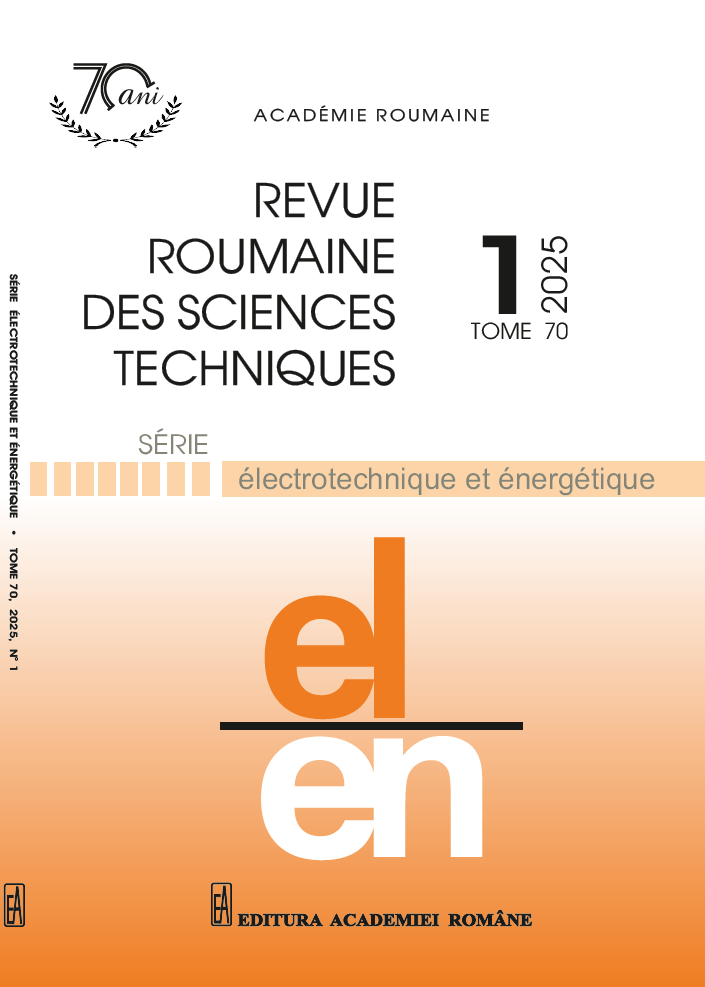ANTENNE À ONDE DE FUITE PÉRIODIQUE À POLARISATION CIRCULAIRE BASÉE SUR UNE LIGNE COAXIALE À FENTE HÉLICOÏDALE
DOI :
https://doi.org/10.59277/RRST-EE.2025.1.15Mots-clés :
Antennes à ondes de fuite, Polarisation circulaire, Balayage de fréquence, Fente hélicoïdale, Antenne à ondes de fuite périodiques (LWA), Communications par satelliteRésumé
Une nouvelle antenne à onde de fuite hélicoïdale (LWA) à polarisation circulaire (PC) basée sur une ligne coaxiale est présentée dans ce travail. La PC est obtenue grâce à une fente hélicoïdale bordant le conducteur extérieur de la ligne coaxiale, ce qui permet un rayonnement contrôlé lorsque le mode TEM fondamental de la ligne coaxiale est alimenté. Ainsi, une LWA de type périodique est formée par balayage fréquentiel d'un faisceau conique et suppression de la bande passante ouverte obtenue grâce au rayonnement continu le long de la fente hélicoïdale. De cette façon, l'efficacité du rayonnement peut être maintenue élevée sur une large plage de balayage. Un prototype a été conçu et fabriqué pour validation avec un balayage de faisceau de -90° à 12° dans la gamme de fréquences 8-16 GHz. L'efficacité est supérieure à 75 % dans la quasi-totalité de cette bande de fréquences avec un rapport axial simulé inférieur à 3 dB, démontrant ainsi de bonnes performances de PC.
Références
(1) D.R. Corrêa, A. Silva de Morais, F.L. Tofoli, Non-isolated quadratic SEPIC converter without electrolytic capacitors for LED driver applications, 15th Brazilian Power Electronics and 5th IEEE Southern Power Electronics Conference, pp. 1–7 (2019).
(2) Y. Wang, J.M. Alonso, X. Ruan, A review of LED drivers and related technologies, IEEE Trans. Ind. Electron., 64, 7, pp. 5754–5765 (2017).
(3) C.C. Raicu, G.C. Seritan, B. Enache, 48 V network adoption for automotive lighting systems, Rev. Roum. Sci. Techn. – Électrotechn. et Énerg., 66, 4, pp. 231–236 (2021).
(4) G. Vacheva, N. Hinov, B. Gilev, Computer investigation of SEPIC DC-DC converter for LED lighting applications, Second Balkan Junior Conference on Lighting, pp. 1–4 (2019).
(5) J. Singh, P. Mahajan, R. Garg, Design & implementation of solar fed intensity-controlled streetlight, 2nd IEEE International Conference on Power Electronics, Intelligent Control, and Energy Systems, pp. 671–676 (2018).
(6) S. Ahmad, N.M.L. Tan, M.Z. Baharuddin, G. Buticchi, A high-performance isolated SEPIC converter for non-electrolytic LED lighting, in IEEE Access, 9, pp. 149894–149905 (2021).
(7) V. Naithani, A.N. Tiwari, S. Dobhal, Simulation of SEPIC converter fed LED’s, International Journal of Engineering Science and Technology, 4, 3, pp. 1015–1020 (2012).
(8) S. Singh, B. Singh, Single-phase SEPIC based PFC converter for PMBLDC motor drive in air-conditioning system, Asian Power Electronics Journal, 4, 1, pp. 16–21 (2010).
(9) D.S.L. Simonetti, J. Sebastian, J. Uceda, The discontinuous conduction mode SEPIC and CUK power factor pre-regulators: analysis and design, in IEEE Trans. on Industrial Electronics, 44, 5, pp. 630–637 (1997).
(10) A. Sureshkumar, R. Gunabalan, Design and implementation of single switch control DC-DC converter with wide input variation in automotive LED lighting, Int. Trans. Elect. Energy Syst., 31, 4 (2021).
(11) M. Dalla Vecchia, G. Van den Broeck, S. Ravyts, J. Tant, J. Driesen, A family of DC–DC converters with high step-down voltage capability based on the valley-fill switched capacitor principle, in IEEE Transactions on Industrial Electronics, 68, 7, pp. 5810–5820 (2021).
(12) S. Hariprasath, R. Balamurugan, A valley-fill SEPIC-derived power factor correction topology for LED lighting applications using one cycle control technique, International Conference on Computer Communication and Informatics, IEEE (2013).
(13) H. Ma, C. Zheng, W. Yu, J.-S. Lai, Bridgeless electrolytic capacitor-less valley fill AC/DC converter for twin-bus type LED lighting applications, 1st International Future Energy Electronics Conference, pp. 304–310 (2013).
(14) D. Dah, C. Lu, Analysis of an AC-DC valley-fill power factor corrector, ECTI Transactions on Electrical Eng., Electronics, and Communications, 5, 2 (2007).
(15) N. Molavi, H. Farzanehfard, Load-independent hybrid resonant converter for automotive LED driver applications, in IEEE Trans. on Power Electronics, 377, pp. 8199–8206 (2022).
(16) Z. Zhang, J. Lin, Y. Zhou, X. Ren, Analysis and decoupling design of a 30 MHz resonant SEPIC converter, in IEEE Transactions on Power Electronics, 31, 6, pp. 4536–4548 (2016).
(17) A. Alexandru, N.V.Petrescu, I.V. Grecu, J.L.G. Tomero, Analysis and design of line-source slotted-coaxial feeders for conical reflectors antennas, International Conference on Communications (COMM) (2018).
(18) A. Alexandru, M.P. Garcia, I.V. Grecu, J. Luis, G. Tornero, Analysis and design of line-source slotted-coaxial feeders for conical reflectors antennas, International Conference on Communications (COMM) (2022).
Téléchargements
Publiée
Numéro
Rubrique
Licence
(c) Copyright REVUE ROUMAINE DES SCIENCES TECHNIQUES — SÉRIE ÉLECTROTECHNIQUE ET ÉNERGÉTIQUE 2025

Ce travail est disponible sous licence Creative Commons Attribution - Pas d'Utilisation Commerciale - Pas de Modification 4.0 International.


